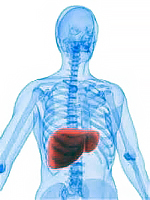In the diagnosis of the early stage of cirrhosis disease, symptoms may generally be absent, which complicates the work of the doctor somewhat, and does not allow to prevent the progressive course of the disease, in particular with alcohol hepatitis. Article about it.
Content
 Practicing specialists from hepatologists and gastroenterologists are known for various liver diseases, alcoholic hepatitis, as a harbinger or initial stage of the liver cirrhosis, whose symptoms indicate this condition, one of them. In 90% of cases of alcohol hepatitis, the reception and abuse of alcohol contribute to the formation of acetaldehyde, affecting the liver tissue cells, besides alcohol and its toxic metabolites provoke their death.
Practicing specialists from hepatologists and gastroenterologists are known for various liver diseases, alcoholic hepatitis, as a harbinger or initial stage of the liver cirrhosis, whose symptoms indicate this condition, one of them. In 90% of cases of alcohol hepatitis, the reception and abuse of alcohol contribute to the formation of acetaldehyde, affecting the liver tissue cells, besides alcohol and its toxic metabolites provoke their death.
Alcohol hepatitis — This is a chronic disease that does not appear immediately, and after 5-7 years after the start of alcohol use, diffuse inflammatory process in the hepatic tissue. The severity of the state is interconnected with a dose of a consumed alcoholic beverage, its quality and duration of reception. Alcohol hepatitis develops in two forms:
- persistent form — a stable state, when the ability and the possibility of reversibility of the inflammatory process is still preserved in the event of a deadly potion reception;
- Progressive shape, three degrees of gravity — Easy, medium, heavy, this is already a small-scale liver damage, in which the outcome of the state in 20% of cases becomes cirrhosis of the liver, the symptoms of which indicate the doctor on the need for urgent treatment of alcoholism, as the only way to save the life of the patient — Hence the answer to the question, whether cirrhosis is treated?.
Forms of alcohol hepatitis
Light forms of hepatitis, including alcoholic, can be revealed with a laboratory survey, but due to the lack of specific manifestations, it almost never happens, because the patient is a little concerned with episodic pains in the right hypochondrium, light nausea and feeling of crowded stomach. With moderate alcohol consumption, chronic-progressive hepatitis can remain unnoticed to 10-15 years, while it is not particularly disturbing the patient. The progressive form of alcoholic hepatitis is usually accompanied by vomiting and diarrhea, jaundice, bleeding, fever appears, severe pain in the right hypochondrium, ascites during liver cirrhosis with the possibility of a deadly outcome of hepatic insufficiency.
Acute alcohol hepatitis can manifest as 4 clinical course options:
- latent — Without an independent clinical picture, only liver biopsy is confirmed;
- icteric — the most common option is expressed by weakness, stupid pain in the right hypochondrium, nausea, increasing body temperature, increasing and liver seal;
- The cholestatic version is accompanied by an unbearable itching, bleaching of the feces, darkening of urine, a protracted flow;
- Fulminant with rapid progression of symptoms, possible hepatic coma and fatal outcome.

The emergence of complications in the last stages, contributes to ascites during the cirrhosis of the liver — The accumulation of fluid in the abdominal cavity that can develop rapidly or slowly and slowly.
In the amount of liquid, the following types of ascites are distinguished during liver cirrhosis:
- Small when the volume of fluid does not exceed 3 liters, there are no symptoms of cirrhosis and it is possible to determine it only with ultrasound or laparoscopy.
- Middle, with a cluster from 5 to 8 liters of exudate, which can lead to a change in the shape of the abdomen, but does not cause a diaphragm movement.
- Large — it is 20-30 liters of liquid in the abdominal cavity, the stomach interferes with movements, but most importantly — There is a violation of breathing.
Whether cirrhosis is treated?
The answer to a similar question should be sought in a state of patient, depending on how one or another volume of liquid in the abdominal cavity is manifested,.E. on the degree of ascites:
- transient — has the ability to cure and disappear after treatment;
- stationary when the fluid continues to remain in the abdomen, despite the treatment;
- tense — characterized by a constant increase in the liquid in the abdominal cavity, despite the treatment.
Ascites in its development can last up to 10 years, which leads to the formation of hepatorenal syndrome. All these complications leave the question open: «Whether cirrhosis is treated?», Often the progressive course of the disease, its complexity, cunning and danger are caused by death.









